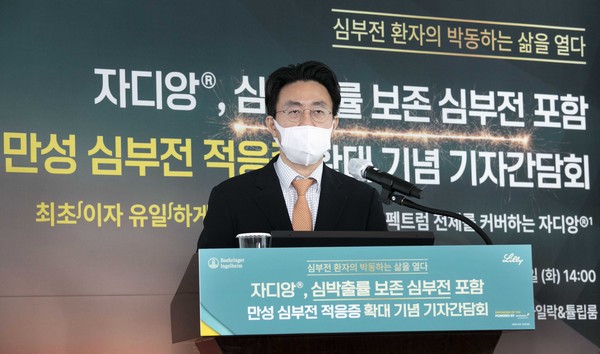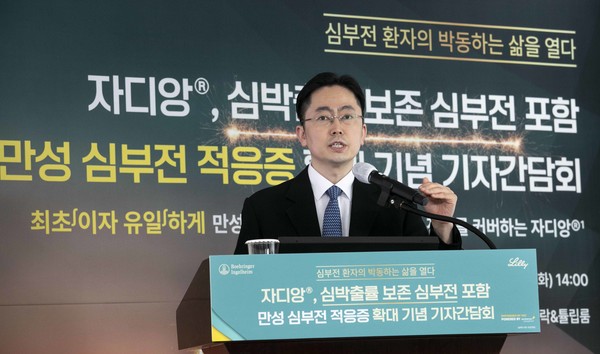Boehringer Ingelheim and Eli Lilly aim to dominate the chronic heart failure market with Jardiance, a Sodium-Glucose Co-Transporter 2 (SGLT-2) inhibitor drug, armed with an expanded indication in treating heart failure with preserved ejection fraction (HFpEF).
HFpEF is a clinical syndrome in which patients have signs and symptoms of heart failure due to high left ventricular (LV) filling pressure despite normal or near-normal LV ejection fraction.
Jardiance has recently emerged as a treatment that covers the entire spectrum of chronic heart failure left ventricular ejection fraction (LVEF). It received approval for the treatment of heart failure with reduced ejection fraction (HFrEF) from the Ministry of Food and Drug Safety in November. In addition, the drug expanded its indication to treat HFpEF in May.
Cardiologists expressed their high expectations for the indication expansion during the media event on Tuesday.

“Until now, there was no treatment for HFpEF, so hospitals had to rely on a limited approach focusing only on symptomatic treatment and treatment of comorbidities,” Professor Cho Hyun-jae of the Department of Cardiology at Seoul National University Hospital said. “Even most HFpEF treatment studies failed to meet the primary efficacy endpoint.”
Cho added that amid the medical community needing a reliable treatment, Jardiance proved that it could become a chronic heart failure treatment that can be used regardless of left ventricular ejection fraction (LVEF) through several clinical trials, stressing that he particularly found the EMPEROR-Preserved clinical study impressive.
“The study, which included only HFpEF patients with an ejection fraction exceeding 40 percent, met the primary endpoint in reducing the relative risk of cardiovascular death or hospitalization for heart failure by 21 percent in HFpEF patients,” Cho said. “Therefore, Korean cardiologists evaluate Jardiance as a treatment that will change the paradigm for chronic heart failure.”

Professor Yoon Jong-chan of the Department of Cardiology at Seoul St. Mary’s Hospital agreed.
“The prognosis improvement effect of Jardiance was consistent regardless of the LVEF,” Professor Yoon said. “Patients with LVEF lower than 65 percent showed an overall significant treatment benefit from Jardiance.”
Although there is disagreement as to whether patients with LVEF lower than 65 percent are actual heart failure patients, the data confirmed the consistent effect of Jardiance, Yoon noted.
He added that the EMPULSE study on 530 hospitalized patients with a primary diagnosis of acute de novo or decompensated chronic heart failure regardless of left ventricular ejection fraction.
“Jardiance achieved the primary endpoint compared to placebo, confirming the treatment effect of all-cause death, reduced heart failure events, and improved symptoms of heart failure,” Yoon said. “The Jardiance group was 36 percent more likely to experience a clinical benefit compared to placebo.”
He explained that these results were consistent in patients with acute or uncompensated chronic heart failure, with or without diabetes, or with decreased or preserved cardiac output.
Yoon emphasized that the study results prove that SGLT-2 inhibitors can be prescribed as first-line treatment for most HFrEF patients, depending on the patient's individual characteristics.
“As SGLT-2 inhibitors, including Jardiance, announced significant clinical results as a treatment for heart failure, major global heart failure guidelines are recommending SGLT-2 treatments as a first option,” he said.
According to Yoon, the European Society of Cardiology (ESC) recommended an SGLT-2 inhibitor as the highest grade 1 as an initial treatment for HFrEF patients in the 2021 heart failure guidelines, and three major U.S. heart associations, including the American College of Cardiology (ACC), the American Heart Association (AHA), and the Heart Failure Society of America (HFSA), recommended SGLT-2 inhibitors for patients with type 2 diabetes, concomitant cardiovascular disease, or high cardiovascular risk from pre-heart failure.

Professor Kang Seok-min, chairman of the Korean Heart Failure Society (KHFS), predicted that Jardiance would become more useful as it has a wide treatment spectrum.
“Jardiance has shown significant benefit in both HFrEF and HFpEF,” Professor Kang said. “Jardiance is currently the first and only treatment clinically proven to reduce cardiovascular death or the risk of hospitalization due to heart failure in chronic heart failure patients regardless of left ventricular ejection fraction (LVEF).”
Therefore, he added that KHFS expects that the treatment will play a new role in heart failure treatment in the Korean clinical field.

